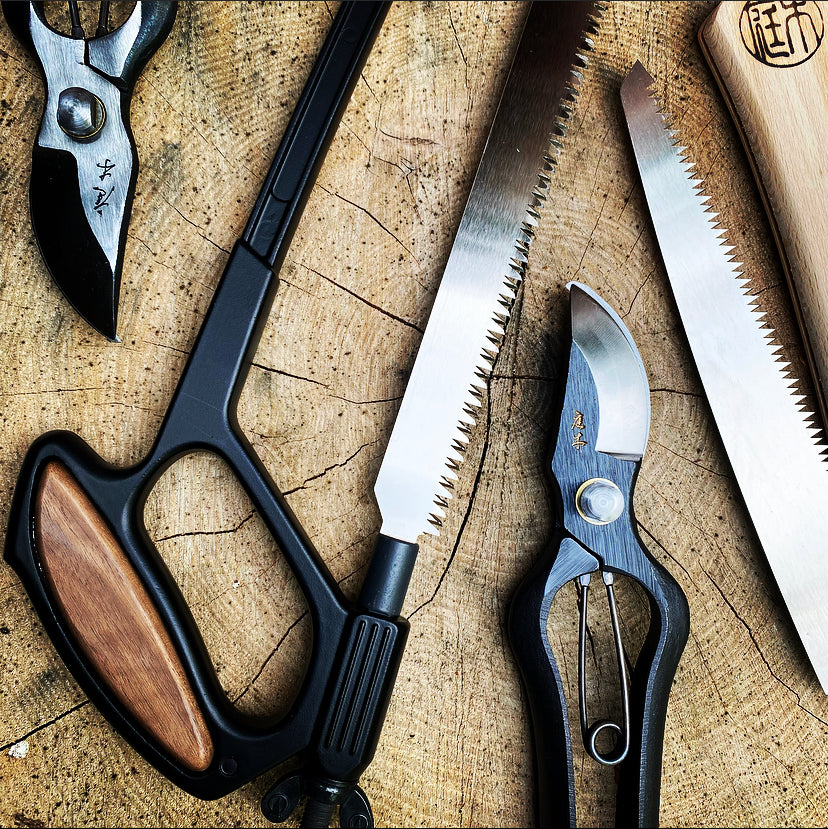
Why are Japanese blades considered to be the best in the world?
Share

Regardless of whether you are thinking about cutting vegetables for dinner, or vegetation to keep your garden in check, they are reputed to be the best. Which is why we both use and stock Niwaki and Fedeca – companies who make astonishingly good blades for gardening and for general use.
Knife craftsmanship and blade making is central to Japanese culture and heritage. Every Japanese blade you buy today, still has a strong connection to the country’s past. So when you are choosing which secateurs to buy or which garden shears to invest in, you perhaps need to answer the question, why wouldn’t you buy blades from the country that has the strongest and longest connection to and knowledge of blade making? Precision is of course important (and other countries that make garden tools will sell this benefit), but sharpness is surely key when you want to cut something? And if you want sharp, you simply have to look to Japanese garden cutting tools because they are sharpest – and we suggest you need go no further than Niwaki.
Japanese blade sharpness is a result of their higher carbon content – the more carbon in the steel leads to a harder steel which can be sharpened to a finer edge. Western high carbon blades usually have less than 0.8% carbon – making them relatively softer. This makes them marginally more durable but more difficult to sharpen to the angles of a Japanese style knife. Japanese blades, have considerably more carbon - with circa 1-3% making them hard, sharp and reputably the best blades in the world.
Alongside the important physical make-up of the blades, we reckon there are few cultural and historic reasons that should help you (regardless of whether you are a gardener or a fan of kitchen or pen knives) decide to choose Japanese blades:
- You probably think our first reason to buy Japanese garden tools is because of the Japanese heritage of making Samurai swords. But kitchen knives played an important role in Japan (in the Heian period 794 to 1185) before sword smithing. The hocho-shiki knife ceremony evolved as a way to present fish and meat dishes to Koko, the 58th Emperor of Japan – so his food wasn’t touched by another human. Skill, a sharp knife plus some chopsticks enabled this to happen. This ritual has defined and influenced both Japanese cooking and the role and importance of making and using quality kitchen knives.
- After the Heian period saw the rise of the Samurai (1185-1868). Alongside their political and cultural legacy, the Samurai era further embedded the skills of blade making. The creation of their legendary weapons, instilled precision-honed, hand-forged blade smithing as an integral part of Japanese culture and business. The switch from making swords, to focusing on kitchen knives and other blades, happened in 1868 when the Emperor Meiji wanted to ‘modernise’ Japan and made it illegal to carry Samurai swords in public. Meaning circa 10 thousand sword makers had to switch their skills to making knifes.
- Japanese blade dominance continues today, a couple of centuries later – because of a cultural obsession with knife making that has been passed down through generations. There is a culture of specialisation and a goal for continuous improvement, alongside a desire to hone and reach perfection of both use and beauty.
So, whilst companies like Niwaki and Fedeca are 21st century companies, they are a modern day iteration of a culture, history and skill set that has been part of Japan for centuries. So when you buy or use your Niwaki garden secateurs, snips and shears – they are a continuation of the evolution of Japanese blade-smithing. Or, when you give a Fedecca ‘make your own penknife’ kit as a gift to a pen knife fan – you’re giving them the chance to personalise their own Japanese penknife which has been born from their centuries of knowledge.

1 comment
I never realized the amount of carbon in a Japanese blade verses the western made blade that so far less.